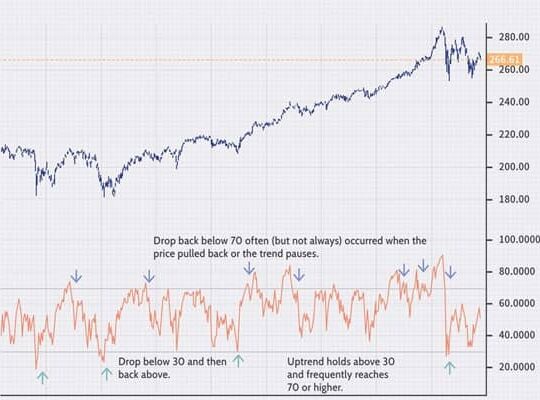Swing trading, which maximizes price variations by focusing on short- to medium-term market moves, has become increasingly popular among capitalist traders. Learning how to leverage the power of MetaTrader is great equipment as this is a robust trading platform equipped with great analytical tools, offering traders an edge in identifying and executing profitable swing trading strategies. By learning how to navigate the short and medium term trend, the traders can completely understand the potential for substantial gains while effectively managing the risks.
Understanding the short and medium term trend before diving into the swing trading strategies can be essential to grasp the dynamics of short and medium term trends. Short term typically last for a few days to several weeks, and characterized by price movements rapidly driven by market sentiment, and news events. Moreover, medium term trends span several weeks to months and are greatly influenced by market factors, economic indicators, and geopolitical developments.
Making use of the short to medium-term trends for swing trading with MetaTrader can be an effective strategy for capitalizing on market fluctuations. Here’s a guide to implementing such strategies:
Understanding Short to Medium-Term Trends
In order to identify the short to medium-term trend can be difficult without the proper technical analysis tools. Utilizing the technical analysis tools within mt4, such as moving averages, trendlines, and indicators like Moving average convergence or divergence or Relative Strength Index can help you identify the medium-term trends in price movements in the market.
- Identifying Key Areas: Determine the areas you want to focus on, such as technology, economy, politics, environment, demographics, or culture.
- Gathering Data: Collect relevant data from reliable sources such as government reports, industry publications, academic research, and reputable news outlets. Data could include statistics, surveys, expert opinions, and case studies.
- Analyzing Trends: Look for recurring patterns, emerging behaviors, and significant changes within your chosen areas. Consider factors like market dynamics, consumer behavior, policy shifts, technological advancements, and social movements.
- Forecasting: Use the gathered data and analyzed trends to make educated predictions about future developments. This could involve extrapolating current trends, identifying potential disruptors, and considering various scenarios and their likelihood.
- Considering Drivers of Change: Understand the underlying drivers influencing the trends. These could be technological innovations, demographic shifts, regulatory changes, economic factors, or cultural movements.
Identify the Entry and Exit Points
Seeking for the entry and exit points in business can help you for your trades. This can be identified in the analysis. This can be an opportunity for you to enter positions when the price is striking and making its trajectory upward (which is for long trades) or downward (which is for short trades). Traders should also consider factors like the support and resistance levels and the strength of trends.
Entry Points:
- Trend Analysis: Use MetaTrader’s charting tools to identify the overall trend. Look for higher highs and higher lows in an uptrend, or lower highs and lower lows in a downtrend.
- Support and Resistance: Identify key support levels in an uptrend and resistance levels in a downtrend using horizontal lines or drawing tools. Look for price reactions at these levels.
- Technical Indicators: Utilize technical indicators such as moving averages, MACD, RSI, or stochastic oscillator to confirm trend direction and potential entry points. For example, entering a long position when a shorter-term moving average crosses above a longer-term moving average in an uptrend.
Exit Points:
- Take-Profit Levels: Determine your profit target based on the distance between entry and potential resistance/support levels. Set a take-profit order at these levels to secure profits.
- Trailing Stop-Loss: Use a trailing stop-loss order to protect profits as the trade moves in your favor. MetaTrader allows you to set dynamic stop-loss levels that adjust automatically as the price moves.
- Reversal Signals: Monitor for reversal signals using technical indicators or candlestick patterns. Exit the trade if there are signs of trend exhaustion or a potential trend reversal.
Leveraging MetaTrader for Swing Trading
Leveraging MetaTrader for swing trading can be a strategic choice due to its robust features and user-friendly interface. Here’s how you can utilize MetaTrader for swing trading:
- Understanding Swing Trading: Swing trading involves holding positions for a few days to several weeks, capitalizing on short- to medium-term price movements within a larger trend. Traders aim to capture “swings” in asset prices, buying at support levels and selling at resistance levels.
- Choosing the Right Assets: Select assets that exhibit clear, recurring price swings and are liquid enough for efficient trading. This could include stocks, forex pairs, commodities, or indices.
- Technical Analysis Tools: MetaTrader offers a wide range of technical analysis tools, including various indicators, charting options, and drawing tools. Utilize these features to identify potential entry and exit points based on price patterns, support and resistance levels, trendlines, and momentum indicators like MACD or RSI.
- Setting Up Swing Trading Strategies: Develop and backtest swing trading strategies using MetaTrader’s built-in strategy tester. This allows you to simulate your trading approach using historical data to evaluate its performance before deploying it in live markets.
- Risk Management: Implement risk management techniques to protect your capital and manage your trades effectively. Set stop-loss orders to limit potential losses and adhere to proper position sizing principles to control risk per trade.
Monitoring and Adjusting Your Swing Trading Approach
As a trader, it is important to continuously assess the price action in the market. By continuously monitoring the price action as well as the market developments can ensure that the trades will remain aligned with the identified trends nowadays. Through utilizing the MetaTrader’s charts which can be real-time and customizable, a great trader can stay informed about the chances and sudden shifts in the market conditions.
Developing a Swing Trading Plan
In trading, there will always be sudden shifts in selling and buying, and an important aspect to learn as a trader is to learn how to adjust it based on the needs. You must be prepared to always adjust your dispositions based on the evolving market trends and new information. Consider the trailing stop-loss orders to lock in profits as the price moves in your favor, while also enabling for potential further gains. Thus, a win-win situation. It really is about the way of the trader to adjust the positions and create a plan based on the needs.
Psychological Aspects in Swing Trading
Whenever we make huge decisions, it is important to isolate our emotions and rationalize. One must be able to stick to the trading plan and avoid emotions whenever we decide because it can affect our way of rationalizing things. Discipline is the key to a successful swing trading, that is why it is important to adhere to predetermined entry and exit criteria, trading strategies, and the risk management rules presented.
For instance, if the price is high, you cannot decide right away just because you are happy about it. You must weigh the pros and cons about it before making and considering a decision.
Fundamental Analysis Considerations
Since trading relies on the economic events, news, and market sentiment, it could make a huge impact on the short to medium term trends. Traders must be able to keep their minds open, and stay informed about the news because this is the number one factor about the fluctuation and inflation of trading. The metatrader provides access to real-time news feeds and economic calendars to help the trader to stay updated on the relevant market developments.
Backtesting Strategies with MetaTrader
By comprehensively understanding the MetaTrader’s way, a great trader can utilize MetaTrader’s strategy tester to backtest your swing trading strategies on historical data. You must be able to analyze the results to fine-tune your approach, optimize parameters, and gain confidence in your trading system before executing live trades. History can also be a great factor in knowing the trends that is why it is important to backtest and study it, and utilize it to your strength as the trader.
Risk Management Techniques
There is nothing that a good trader cannot do, one must be able to manage the risk effectively by diversifying the trades, limiting the position sizes, and making sure to avoid the way of over leveraging. You must keep track of your trading performance and learn how to adjust the risk management strategies accordingly.
- Position Sizing: Determine the size of each position based on your account size, risk tolerance, and the distance to your stop-loss level. Avoid risking more than a small percentage of your trading capital on any single trade (typically 1-2%). Use MetaTrader’s position sizing calculator or risk management tools to calculate the appropriate position size based on your risk parameters.
- Stop-Loss Orders: Always use stop-loss orders to limit potential losses on each trade. Place stop-loss orders below support levels for long trades and above resistance levels for short trades. Set stop-loss levels based on technical analysis, volatility, and the timeframe you’re trading on. Regularly adjust stop-loss orders as the trade progresses to lock in profits and protect against adverse price movements.
- Take-Profit Targets: Set realistic take-profit targets based on support/resistance levels, technical indicators, or predefined risk-reward ratios. Consider taking partial profits at predefined levels to secure gains while allowing the remainder of the position to run if the trade continues in your favor. Use MetaTrader’s order management features to set take-profit orders automatically when entering a trade.
Conclusion
Trading is hard, and there is nothing greater than seeing the market hit its highest. In the realm of swing trading, the ability to adeptly navigate about the short and medium term trends is paramount to success. By harnessing the analytical power of MetaTrader and employing effective trading strategies tailored to prevailing market conditions. Regardless of following the trends, trading breakouts, capitalizing on news events, and exploiting range-bound conditions. By following these steps and leveraging MetaTrader’s tools and features, you can develop effective swing trading strategies that capitalize on short to medium-term trends in the financial markets. Remember to continuously refine your approach based on market conditions and your own trading experiences.
FAQs
- What is swing trading, and how does it differ from other trading styles?
- Swing trading is a trading style that aims to capture short to medium-term trends in the financial markets. Unlike day trading, which involves opening and closing positions within the same trading day, swing trading typically involves holding positions for several days to weeks to capitalize on price movements.
- How can MetaTrader help me identify short to medium-term trends for swing trading?
- MetaTrader provides a variety of technical analysis tools, including indicators, chart patterns, and customizable charting features, that can help traders identify short to medium-term trends in price movements. Traders can use tools such as moving averages, trendlines, MACD, RSI, and Fibonacci retracements to analyze market trends and make informed trading decisions.
- What are some effective indicators for identifying short to medium-term trends in MetaTrader?
- Some effective indicators for identifying short to medium-term trends in MetaTrader include moving averages (such as the 50-day and 200-day moving averages), the MACD (Moving Average Convergence Divergence), RSI (Relative Strength Index), and Bollinger Bands. These indicators can help traders identify trends, momentum, and potential reversal points in the market.








